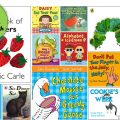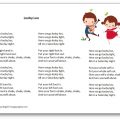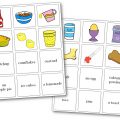Author: Nick Sharratt
Illustrator: Nick Sharratt
Publisher: Scholastic
Year: 2004
Language: English
Type of resource: Illustrated picture book with wordplay
Themes: Food, humor, imaginary animals, prohibitions, rhymes
Age range: 3 to 8 years old
School levels: Preschool, Kindergarten, Grade 1, Grade 2
Main learning objective: To explore and use food and animal-related vocabulary through a humorous and imaginative text.
Main language objective: I can name animals and food, and understand funny warnings.
Summary of the Book
In this humorous picture book, the author invites children not to put their fingers in the food! Each double-page spread introduces a food item and a name that rhymes with it, followed by a made-up animal that appears if the rule is broken: a jellyphant in the jelly, a meringue-utan in the pie, or a choctopus in the milkshake. With bright, playful illustrations and rhyming text, the book delights young readers with surprises and laughter. The repetitive structure supports vocabulary development and encourages prediction and participation.
Culture and Vocabulary
The book references food items typical of British or North American culture (jelly, pie, jam, pasta, shake, doughnut), paired with both familiar and exotic animals. The story highlights English names and rhymes, which support phonological awareness and memorization. It also showcases a distinctive form of British humor, combining creativity and sound play to invent funny animal-food hybrids.
Food vocabulary: jelly, pie, cheese, jam, pasta, shake, doughnuts
Anglo-saxon names: Nelly, Guy, Louise, Sam, Jocasta, Jake, Claire
Real and imaginary animals: Jellyphant (jelly + elephant), meringue-utan (meringue + orangutan), alligrater (grater + alligator), spag-yeti (spaghetti + yeti), choctopus (chocolate + octopus)
Common verbs: put, upset, wake up, like
Taste/texture adjectives for extension: sweet, sticky, cold, creamy, salty, crunchy, soft
Grammar and Structures
- Imperative negative: “Don’t put your finger in the jelly, Nelly!” – The repeated command helps learners understand and use negative imperative forms.
- Rhyming names and food pairings: “Nelly/jelly, Guy/pie, Jake/shake” – Supports phonological awareness and rhyme recognition.
- Present simple with “put”: “put your finger…” – Useful, functional verb presented in a highly repetitive form.
- Modal with consequence: “You might upset a jellyphant!” – Shows how to express possible outcomes.
- Compound imaginary nouns: “jellyphant”, “choctopus” – Encourages creativity and word formation.
- Contracted form: “Don’t” – Introduces commonly used contractions in a meaningful context.
- Implied indirect question or suspense: The final page references all previous characters with a twist, enhancing narrative skills.
Phonology
- Rhymes and rhythm: Nelly/jelly, Guy/pie, Jake/shake – Supports rhyme awareness and fluency.
- Key sounds: [ʒ], [ʃ], [k], [p] in words like jelly, shake, cheese, pie
- Assonance and alliteration: choctopus, clawberry, spag-yeti
- Contrasting sounds: Louise/cheese, Sam/jam
- Exclamatory and rhythmic intonation: Natural English speech prosody
- Repetition of “Don’t put your finger…”: Enhances auditory memory and pronunciation through pattern recognition
Teaching Suggestions
Before Reading
- Observe the book cover and make predictions about the story
- Introduce basic food vocabulary using flashcards or real objects
- Present English names using illustrated name tags
- Sensory play with real food items (smelling, touching, tasting)
During Reading
- Repeat key phrases together as a class
- Pause after each page to guess the animal or “danger”
- Imitate sound effects and exaggerated reactions of characters
After Reading
- Match each imaginary animal to its food in a sorting game
- Create a new animal-food combination: Don’t put your finger in the honey, Johnny! There’s a bee-lion inside!
Grammar Mini-lesson
- Practice negative imperatives with command cards: Don’t touch, Don’t eat…
- Explore contractions: Do not → Don’t using simple reformulations in pairs
Cross-Curricular Connections
Music: Sing the song Do You Like Broccoli Ice Cream? to extend food vocabulary in a fun way
Visual Arts: Draw and invent a food-animal character inspired by Nick Sharratt’s style
Civic Education: Talk about hygiene and why we shouldn’t put our fingers in food
Media Literacy: Create a fake commercial for a food-animal creature
Project Idea: “My Silly Food Creature Book”
Class project: Create a class book inspired by Don’t Put Your Finger in the Jelly, Nelly!
Objective: Each child invents a rhyme with a name, food, and animal, illustrates the page, and writes their sentence. The project can be extended over several sessions and result in a collective display or book.
Book extension: Read Ketchup on Your Cornflakes? by Nick Sharratt to continue playing with food vocabulary in English.
Conclusion
Don’t Put Your Finger in the Jelly, Nelly! is a valuable resource to explore food and animal vocabulary while having fun with sounds and imagination. Its repetitive, humorous structure makes it especially suitable for young English learners. Whether used in preschool or early primary grades, it captures attention, encourages oral participation, and boosts language creativity. An engaging and effective book to include in any ESL teaching library.





